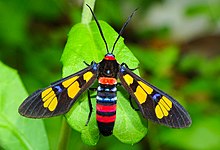| Wasp Moth / Painted Handmaiden Moth | |
|---|---|

| |
|
Scientific classification
| |
| Domain: | Eukaryota |
| Kingdom: | Animalia |
| Phylum: | Arthropoda |
| Class: | Insecta |
| Order: | Lepidoptera |
| Superfamily: | Noctuoidea |
| Family: | Erebidae |
| Subfamily: | Arctiinae |
| Genus: | Euchromia |
| Species: | E. polymena
|
| Binomial name | |
| Euchromia polymena | |
| Synonyms | |
| |
Euchromia polymena is a species of day flying moth of the subfamily Arctiinae. These moths are vibrantly coloured and look like wasps so known as Wasp moth [1] or Painted handmaiden moth. [2] It was described by Carl Linnaeus in his 1758 10th edition of Systema Naturae. It is found in India and south-eastern Asia, as well as on Sumatra, Java, Sulawesi, Peninsular Malaysia, Borneo and the Philippines. [3] It is also present in the northern part of Western Australia and the Northern Territory.
Hindwings have veins 3 and 4 extending from the angle of the cell. The body is black, with a blue spot on the vertex of the head. The frons is white, and the tegulae feature a white spot. The collar and the 1st, 4th, and 5th abdominal segments are crimson, while the 2nd, 3rd, and 6th segments are edged with metallic blue. Forewings have a basal metallic-blue spot and two spots at the end of the cell. They also feature a large sub-basal spot, a bifid medial spot, and a quadrified post-medial orange spot. The hindwing displays trifid basal and quadrified post-medial orange spots. The coxa of the forelegs and three spots on the pectus are white. The larva is reddish with red tubercles. It has long anterior and posterior tufts of hair and shorter dense medial dorsal tufts. Pupa is in a hairy cocoon. [4]
The eggs are shiny pale yellow spheres, and laid in groups under a leaf of a food plant. The larvae feed on Ipomoea species. The caterpillars live in groups until the last instar which is solitary. [5]
-
Mating
-
Laying eggs
-
Larva
-
Pupa
- ^ Krishna Mohan Photography
- ^ Rahul Alvares
- ^ Savela, Markku. "Euchromia polymena (Linnaeus, 1758)". Lepidoptera and Some Other Life Forms. Retrieved 18 November 2018.
- ^ Hampson, G. F. (1892). The Fauna of British India, Including Ceylon and Burma: Moths Volume I. Taylor and Francis – via Biodiversity Heritage Library.
- ^ Herbison-Evans, Don & Crossley, Stella (22 November 2014). "Euchromia polymena (Linnaeus, 1758)". Australian Caterpillars and their Butterflies and Moths. Retrieved 18 November 2018.
- Pitkin, Brian & Jenkins, Paul. "Search results Family: Arctiidae". Butterflies and Moths of the World. Natural History Museum, London.
| Wasp Moth / Painted Handmaiden Moth | |
|---|---|

| |
|
Scientific classification
| |
| Domain: | Eukaryota |
| Kingdom: | Animalia |
| Phylum: | Arthropoda |
| Class: | Insecta |
| Order: | Lepidoptera |
| Superfamily: | Noctuoidea |
| Family: | Erebidae |
| Subfamily: | Arctiinae |
| Genus: | Euchromia |
| Species: | E. polymena
|
| Binomial name | |
| Euchromia polymena | |
| Synonyms | |
| |
Euchromia polymena is a species of day flying moth of the subfamily Arctiinae. These moths are vibrantly coloured and look like wasps so known as Wasp moth [1] or Painted handmaiden moth. [2] It was described by Carl Linnaeus in his 1758 10th edition of Systema Naturae. It is found in India and south-eastern Asia, as well as on Sumatra, Java, Sulawesi, Peninsular Malaysia, Borneo and the Philippines. [3] It is also present in the northern part of Western Australia and the Northern Territory.
Hindwings have veins 3 and 4 extending from the angle of the cell. The body is black, with a blue spot on the vertex of the head. The frons is white, and the tegulae feature a white spot. The collar and the 1st, 4th, and 5th abdominal segments are crimson, while the 2nd, 3rd, and 6th segments are edged with metallic blue. Forewings have a basal metallic-blue spot and two spots at the end of the cell. They also feature a large sub-basal spot, a bifid medial spot, and a quadrified post-medial orange spot. The hindwing displays trifid basal and quadrified post-medial orange spots. The coxa of the forelegs and three spots on the pectus are white. The larva is reddish with red tubercles. It has long anterior and posterior tufts of hair and shorter dense medial dorsal tufts. Pupa is in a hairy cocoon. [4]
The eggs are shiny pale yellow spheres, and laid in groups under a leaf of a food plant. The larvae feed on Ipomoea species. The caterpillars live in groups until the last instar which is solitary. [5]
-
Mating
-
Laying eggs
-
Larva
-
Pupa
- ^ Krishna Mohan Photography
- ^ Rahul Alvares
- ^ Savela, Markku. "Euchromia polymena (Linnaeus, 1758)". Lepidoptera and Some Other Life Forms. Retrieved 18 November 2018.
- ^ Hampson, G. F. (1892). The Fauna of British India, Including Ceylon and Burma: Moths Volume I. Taylor and Francis – via Biodiversity Heritage Library.
- ^ Herbison-Evans, Don & Crossley, Stella (22 November 2014). "Euchromia polymena (Linnaeus, 1758)". Australian Caterpillars and their Butterflies and Moths. Retrieved 18 November 2018.
- Pitkin, Brian & Jenkins, Paul. "Search results Family: Arctiidae". Butterflies and Moths of the World. Natural History Museum, London.



